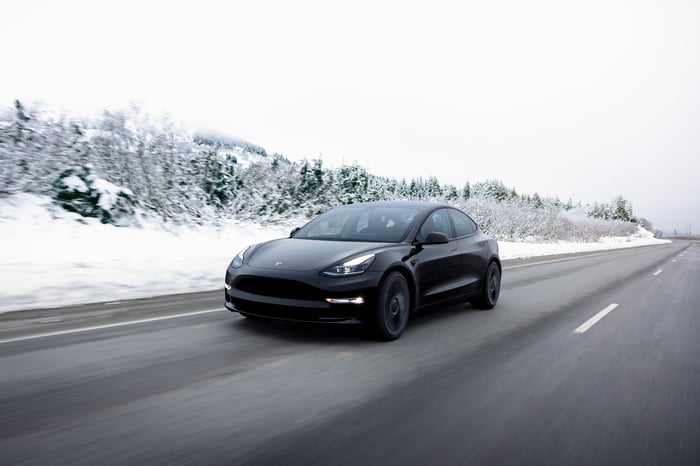In 2016, Tesla (TSLA -1.11%) CEO Elon Musk first revealed plans to develop a fully autonomous self-driving robotaxi. While it's still not on the road seven years later, he just hinted it's closer than ever -- it might even be ready this year.
In a wide-ranging interview with CNBC's David Faber yesterday, Musk added a little more color to his vision for the project, and serving as a self-driving ride-hailing platform appears to be a big part of the value proposition.
The undisputed global ride-hailing leader today is Uber Technologies (UBER -0.38%), which is currently working on its own self-driving technology. But with a giant like Tesla entering the space, should Uber be worried?

Image source: Tesla.
Tesla's robotaxi could become its greatest value creator
To be clear, the robotaxi won't necessarily be a new Tesla model. Instead, Musk's goal is to have as many customer-owned Teslas serving as robotaxis as possible by having them install the company's self-driving software.
In the interview, he talked about how the average passenger car is used for just 10 to 12 hours per week, spending most of its time parked at its owner's home or place of work, which makes the value proposition incredibly inefficient. By installing autonomous software, those vehicles could spend that idle time out on the road as part of a ride-hailing network, earning money for both the owner and for Tesla.
Musk touched on the potential business model, describing a revenue split that could run 50/50 or even 70/30 in favor of the car owner. This could absolutely transform Tesla's financials, because instead of just manufacturing a vehicle and selling it with a gross profit margin of 25%, each car would potentially earn a margin of 70% (or higher) over time.
What could that translate to in dollar terms? Musk referenced the analysis of Cathie Wood and her firm Ark Investment Management, which issued some projections earlier this year suggesting autonomous ride-hailing could generate $4 trillion in revenue by 2027. It could also create $14 trillion in enterprise value in the process.
That's why the robotaxi also underpins Ark's $2,000 price target for Tesla stock in 2027, which is the highest on Wall Street. Ark predicts the autonomous platform will be responsible for 67% of the company's $6.1 trillion in enterprise value by that time -- if that were true today, it would be the single most valuable piece of technology in the world.
Uber might already have a head start
Tesla's autonomous driving software is widely considered to be the most advanced in the industry, with 2.7 million cars on the road specifically collecting data, which is 10 times more than its closest competitor.
But Uber has a huge advantage in its digital platform, with over 130 million monthly users, who completed 2.1 billion rides in the first quarter of 2023 alone. Since human drivers are the company's largest expense, an autonomous solution would simply represent the natural progression of its business model.
Uber has a difficult history with autonomous technology, having abandoned its in-house development project in 2020 after one of its test vehicles killed a pedestrian a couple of years earlier. However, last year, it signed a 10-year deal with a company called Motional, which is a joint venture between Korean automotive giant Hyundai and mobility technology company Aptiv.
Motional has developed a driverless platform on top of Hyundai's Ioniq 5 electric vehicle. It has achieved SAE (Society of Automotive Engineers) Level 4, which means the vehicle is fully autonomous and can handle all driving and navigational tasks without human input. Motional was missing a ride-hailing ecosystem, which is what Uber brings to the table.
Together, the companies could theoretically deploy the largest autonomous ride-sharing network in the world.
The Tesla-Uber battle will be epic
Elon Musk hinted that Tesla will adopt a closed-loop ecosystem when it comes to its autonomous platform. In other words, self-driving Teslas can only operate within Tesla's ride-hailing network -- they can't be used to work for Uber, for example.
That effectively ensures the company earns income from its software in perpetuity. If new electric vehicles do completely displace sales of internal combustion vehicles and Tesla remains the most popular electric vehicle brand, this closed-loop strategy could quite literally be worth trillions of dollars.
On the other hand, as I mentioned, Uber has a major head start with users. Will everyday non-Tesla owners download another smartphone application just so they can specifically hail a Tesla? That's the biggest question. Tesla might have an abundance of supply on the road, but if users prefer to stick with Uber, it won't be very successful.
For that reason, it's too early for Uber to fear this impending threat, especially if it delivers a comparably good autonomous solution through its partnership with Motional. If investors want to hedge their bets, this emerging industry is a good-enough reason to buy both Tesla and Uber stock.





